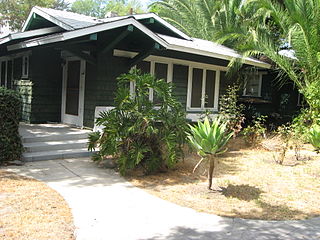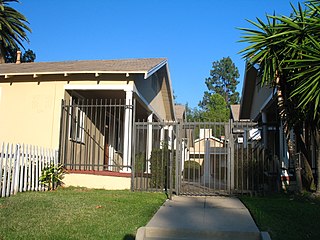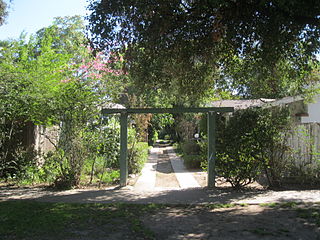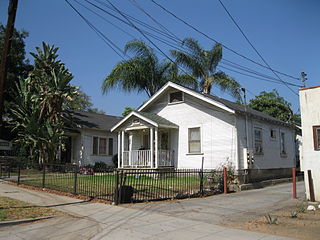
Pasadena is a city in Los Angeles County, California, United States, 11 miles (18 km) northeast of Downtown Los Angeles. It is the most populous city and the primary cultural center of the San Gabriel Valley. With its substantial downtown area, observers consider it as either a suburb of nearby Los Angeles, or as a significant urban center in its own right.

The Villa District, also known as Villa Historic District, is a historic district in Chicago, Illinois, United States. It is located on Chicago's Northwest Side within the community area of Irving Park. Its borders are along Pulaski Road to the west, the Union Pacific/Northwest rail line to the north, Hamlin Avenue to the east, and Addison Street to the south. Located directly north of the Wacławowo area of Avondale, the Villa District is serviced by the Blue Line's Addison street station.

The Drake Park Neighborhood Historic District is located adjacent to Drake Park near the historic downtown area in Bend, Oregon, United States. Because of the unique and varied architecture in the Drake Park neighborhood and its close association with the early development of the city of Bend, the area was listed on the National Register of Historic Places in 2005.

Bungalow Heaven is a neighborhood in Pasadena, California named for the more than 800 small craftsman homes built there from 1900 to 1930, most of which still stand. Much of the area became a landmark district in 1989 and annual historic home tours have been conducted in Bungalow Heaven every year since then.

This is a list of the National Register of Historic Places listings in Pasadena, California.

Old Towne, Orange Historic District, a one square-mile around the original plaza of Orange, California, contains many of the original structures built in the period after the City's incorporation. It is a vibrant commercial district, containing Orange County's oldest operating bank and the oldest operating soda fountain. The Historic District was listed on the National Register of Historic Places in 1997, and is the largest National Register District in California. The Old Towne Preservation Association is a non-profit organization dedicated to maintaining the district.

The Oak Circle Historic District is a historic district in Wilmette, Illinois, United States. The district covers 2.6 acres (0.011 km2) and includes twenty-two contributing properties and four non-contributing properties, all located along Oak Circle. It primarily consists of fifteen single-family homes representative of the Prairie School and Craftsman styles of architecture. The Oak Circle Historic District was added to the National Register of Historic Places on June 21, 2001; it was the first historic district to be designated in Wilmette.

Bowen Court is a bungalow court located at 539 E. Villa St. in Pasadena, Los Angeles County, California. The court includes 23 bungalows arranged in an "L" shape and is one of the largest bungalow courts in southern California. Built from 1910 to 1912, Bowen Court is the oldest bungalow court in Pasadena. The court was designed by Arthur and Alfred Heineman, who planned the court around a Craftsman style courtyard.

Bryan Court is a bungalow court located at 427 S. Marengo Ave. in Pasadena, California. The court includes seven Craftsman-style homes surrounding a central courtyard. The stucco houses are designed to resemble English cottages and have porches and jerkinhead roofs. D. M. Renton built the court in 1916.

Don Carlos Court is a bungalow court located at 374–386 S. Marengo Ave. in Pasadena, California. The court contains seven homes built around a central courtyard and walkway. The homes were designed in the Spanish Colonial Revival style and were all built with stucco facades and tiled gable roofs. The courtyard includes a decorative birdbath and planter. Contractor Clarence Hudson Burrell built the court in 1927.

Cottage Court is a bungalow court located at 642–654 S. Marengo Ave. in Pasadena, California. The court consists of seven houses surrounding a narrow courtyard. The stucco homes were built in 1923 and designed in the Colonial Revival style. The designs feature gable roofs with wide eaves and recessed porches with supporting columns. The courtyard includes a walkway and two light poles.

The Court at 744-756½ S. Marengo Ave. is a bungalow court located at 744-756½ S. Marengo Ave. in Pasadena, California. The court includes six buildings containing fourteen residential units centered on a driveway. Two of the buildings are two stories tall, while the remainder are one story. Contractor D. J. Ringle built the court in 1931. The homes were designed in the Art Deco style and feature fluted parapets and engaged piers. The court is one of the few Art Deco residential properties in Pasadena and has thus been called "probably the most unusual" bungalow court in the city.

Marengo Gardens is a bungalow court located at the intersection of South Marengo Avenue and Ohio Street in Pasadena, California. The court, which was built in 1913, consists of nine single-family bungalows; six of the houses are centered on a courtyard, while the remaining three face Marengo Avenue. The homes were designed in the American Craftsman style; each house includes various different features of the style, such as shingle or clapboard siding, shallow-sloped gable roofs, decorative brickwork, and buttressed piers.

Palmetto Court is a bungalow court located at 100 Palmetto Dr. in Pasadena, California. The court consists of twelve single-family homes arranged along two central pathways with a two-unit building at the end of the paths. A torii-like gate is located at the court's street entrance. Contractor A. C. Parlee built the court in 1915. The homes in the court are designed in the American Craftsman style and feature both shingle and clapboard siding and a variety of roof styles including jerkinhead, gable, and shed.

Sara-Thel Court is a bungalow court located at 618-630 S. Marengo Ave. in Pasadena, California. The court includes seven buildings arranged around a central walkway; six of the buildings are single-family units, while a double unit is located at the end of the walkway. Built in 1921, the court was designed by Jas. Humphreys. The houses were mainly designed in the American Craftsman style and feature gable roofs with shallow slopes and exposed rafters; the moldings on the homes were inspired by the Colonial Revival style.

The Lower Arroyo Seco Historic District is a residential historic district in Pasadena, California. The historic district encompasses homes located near the lower Arroyo Seco along Arroyo Boulevard, California Boulevard, La Loma Road, and Grand Avenue. The district includes 78 contributing homes, the majority of which were influenced by the Arts and Crafts movement. During the early twentieth century, when most of the homes in the district were constructed, Pasadena was one of three prominent centers of American Craftsman design, along with Chicago and the San Francisco Bay Area. The district includes a variety of Craftsman designs only matched by one other area in California, a hilly neighborhood in Berkeley. Several prominent architects, including Charles K. Sumner and Henry Mather Greene, designed homes in the district. The Batchelder House, home of tile designer Ernest Batchelder, is included in the district.

The House at 530 S. Marengo Avenue is a historic house in Pasadena, California. Built in 1905, the American Craftsman house was designed by Pasadena architect Louis B. Easton. Easton was one of several prominent Craftsman architects in Pasadena in the early 1900s; the house at 530 S. Marengo, located next to his own self-designed house at 540 S. Marengo, was one of his earliest designs. The house features exposed beams and hand-carved joint work in the spirit of the Craftsman style, which emphasized function over form. The interior of the home was inspired by homes in The Craftsman, Gustav Stickley's architecture magazine, which ultimately featured some of Easton's later works.

The Court at 1274–1282 North Raymond Avenue is a bungalow court located at 1274–1282 North Raymond Avenue in Pasadena, California. The court consists of five one-story bungalows arranged around a central courtyard. The houses are designed in a blend of the Colonial Revival and American Craftsman styles; the former can be seen in the entrance porticos on three of the buildings, while the latter is present in the homes' overhanging eaves and exposed rafter tails. Owner Karl Valentine designed and built the court in 1924–25.

The Court at 533-549 North Lincoln Avenue is a bungalow court located at 533-549 North Lincoln Avenue in Pasadena, California. The court consists of four bungalows surrounding a central courtyard and driveway. The bungalows have an American Craftsman design and feature gabled roofs with exposed rafter tails, casement windows, and porches supported by Doric columns. T. G. Grabham, the original owner of the court, built the four homes between 1922 and 1925. Architect G. Tombelson designed the first two homes, which were both built in 1922; contractors Whitescarver & Pieton added the third home in 1923, and contractor Joseph G. Roth built the last in 1925.

The Park Place–Arroyo Terrace Historic District is a residential historic district located in northwest Pasadena, California. The district includes eleven contributing houses built from 1902 to 1912. Most of the houses in the district were influenced by the Arts and Crafts Movement, which was popular in Pasadena in the early 20th century; particular styles in the district include the American Craftsman house, the Craftsman bungalow, the Colonial Revival house, and the Prairie School house. Prominent Pasadena architects Charles and Henry Greene designed seven of the district's houses; the district is the most concentrated collection of their works in Pasadena. Two other noted Craftsman architects, Myron Hunt and Sylvanus Marston, also designed homes in the district, including Hunt's own residence.

























